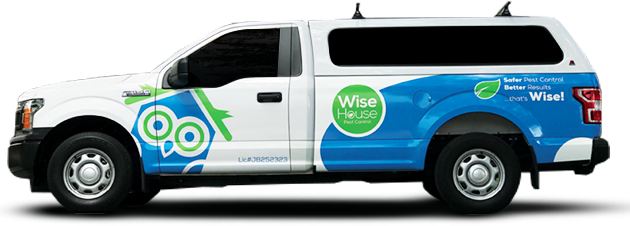Do your doors and windows seem harder to close than before? If you live in South Florida, these could be telltale signs of Dampwood Termites taking over your home.
These termites are popular for their preference for moist wood and can cause significant structural damage if left unchecked. If dampwood termites are eating away the structure of your home, what should you do next? How can you effectively rid your home of these unwelcome guests and prevent them from coming back again? Let’s take a closer look at what you can do if you find yourself in this situation.
Dampwood termites are a larger type of termite that can pose a serious threat to homes and buildings. They typically range from 3/4 inch to 1 inch in size and are characterized by their light brown to reddish-brown color. Dampwood termites have six legs, antennae, and wings on alates or swarmers.
These termites are attracted to moist and weakened wood, making them a concern for residential areas with high humidity or moisture issues such as South Florida. They often target timber, decaying wood sources, felled timber, dead trees, stumps, and buildings that have plumbing or drainage issues leading to elevated moisture levels. Unlike other termites, they construct mud tubes and instead reside within the wood they consume, sealing entry points with feces to maintain optimal moisture levels for their habitat.
In South Florida, dampwood termites are often found in areas like Miami’s Everglades, the wetlands of the Florida Keys, and even suburban neighborhoods with lush vegetation and high humidity levels, such as those in Boca Raton, Port St. Lucie, Boynton Beach and West Palm Beach.
Homes near the edges of the Everglades or in coastal areas like Fort Lauderdale are particularly susceptible to dampwood termite infestations due to the moist environment and abundant wood sources. Homeowners in these regions should closely monitor areas with wooden structures, like decks or fences, and swiftly address any signs of termite activity to avoid costly damage.
Spotting dampwood termites early on can save your South Florida home from serious trouble down the line. Here’s a few signs you should look for:
When dampwood termites feed, they often make quiet tapping or clicking sounds within the wood, which can sometimes be heard by homeowners. These sounds are produced as the termites communicate with each other through vibrations and tapping their heads against the wood tunnels. Paying attention to such noises, especially when it’s quiet in your home, can help detect an early infestation.
Dampwood termites are noticeably larger and than other termite species, making them easier to spot. If you see these termites, often with a creamy to dark brown color, it’s a definitive sign of infestation. They may be visible when infested wood is removed or during their swarming season when they emerge to mate.
Wood affected by dampwood termites often appears darker or discolored due to the moisture the termites bring into the wood. This discoloration can be a sign of an active termite presence, as these pests prefer and create moist environments to live and feed in.
A musty, mold-like odor can emanate from areas where dampwood termites are active. This smell arises from the high moisture levels they maintain within their habitat, combined with the decay of wood and other organic materials they consume. Detecting this scent can indicate a termite problem, especially in conjunction with other signs.
While dampwood termites do not produce as much frass (termite droppings) as drywood termites, small piles of frass can still accumulate near infested areas. Unlike the dry pellets from drywood termites, dampwood termite frass may be stickier and less uniform, often sticking to the wood from where it was excreted.
Wood that sounds hollow when tapped is often a sign of termite damage inside. Dampwood termites consume wood from the inside out, leaving a thin veneer of surface wood intact, which leads to a hollow sound when knocked. Inspecting wood that sounds hollow can reveal termite activity and the extent of damage.
As dampwood termites burrow and feed, they can create visible cracks or holes in the wood’s surface. These openings are used by the termites to enter and exit their feeding sites within the wood. Regularly inspecting wood for such abnormalities can help identify termite presence early.
Paint or wallpaper that is bubbling, peeling, or cracking can indicate underlying moisture issues, often caused by termite activity. Dampwood termites introduce moisture into wooden structures, which can lead to the deterioration of paint and wallpaper finishes, signaling an infestation.
Flooring that becomes loose, warped, or detached may be a consequence of excess moisture from termite activity. Dampwood termites increase moisture levels in wooden substructures, affecting adhesive and causing flooring materials to warp or become loose. This can be particularly evident in areas where flooring materials meet wooden substructures.
Stop Dampwood Termites in Their Tracks! Hire An Expert Pest Control Company to handle your infestation. Contact Wise House Environmental Services today! Call us at 561-727-8239.
Once you’ve identified the presence of dampwood termites, the next step is addressing the infestation effectively. Getting rid of dampwood termites in South Florida requires a strategic approach that typically involves moisture control, direct treatment of infested wood, and sometimes, the complete removal of affected areas. Here’s how you can tackle the problem:
Controlling moisture is critical in deterring dampwood termites. Inspect your property for any water leaks, condensation, or poor drainage issues and address them promptly. Fix leaky faucets, pipes, and roofs, and ensure gutters and downspouts are clean and directing water away from the foundation. In areas prone to dampness, like garages and crawl spaces, using dehumidifiers can help reduce humidity levels, making the environment less inviting for termites.
Regularly check the wood structures in your home for signs of termite damage, such as hollow spots or a spongy feel. Replace wood that is severely infested or structurally compromised with termite-resistant materials if possible. For less severe infestations, applying localized termiticide treatments can eradicate termites in specific areas. Ensuring that wood surfaces are properly sealed can also prevent future termite entry.
Hire a local pest control company in Florida to conduct regular termite inspections for early detection and management of termite activity. These inspections can identify potential problem areas and conditions that may attract termites before they cause significant damage. Professionals can also monitor for new termite activity and implement control measures as needed.
Keeping your property dry and well-ventilated is essential to make it less appealing to dampwood termites. Ensure that crawl spaces, attics, and garages have adequate ventilation to reduce moisture. Use vapor barriers in crawl spaces to protect against ground moisture. Regular maintenance, such as clearing vegetation from around the building’s perimeter and ensuring that wood does not directly contact the soil, can prevent moisture accumulation and termite access.
Yes, termites are a significant problem in South Florida due to its humid and warm climate, which provides ideal conditions for termite activity and survival, especially for dampwood and subterranean termites.
To get rid of dampwood termites in Florida, it’s essential to reduce moisture sources, repair leaks, and eliminate wood-to-ground contact. Professional termite control services can apply targeted treatments to infested areas, using effective pest control solutions or replacing affected wood as needed.
The most common termites in Florida are subterranean termites, including the native Eastern subterranean termite and the invasive Formosan termite. However, dampwood and drywood termites are also prevalent in the state.
Signs of dampwood termite infestation include seeing swarmers or discarded wings, finding their large, irregular fecal pellets, and noticing damaged wood that appears clean and smooth inside.
Pictures of South Florida dampwood termites can be found on pest control websites, entomology databases, or through local extension services to help homeowners identify these pests.
To eliminate dampwood termites, address moisture issues, remove infested wood, and consult with a pest control professional for appropriate treatments.
Dampwood termites are typically larger, prefer moist wood, and do not require soil contact, unlike drywood termites, which are smaller, infest homes through airborne swarms, and can survive in drier conditions.

Ready to send away pests without harming your pets? Getting started with Wise House Environmental Services is as easy as 1-2-3:
With Wise House Environmental Services, you get more than just effective pest control; you get peace of mind, knowing that your home is without pests and safer for your pets.
Our approach to pest control combines science with safety, offering you the kind of targeted, effective solutions that you won’t find with just any other pest control service. Our services have made a world of difference for homeowners, and we can do the same for you. Your pets will thank you for it!
We serve Port St. Lucie,Lake Worth, Boyton Beach, Palm Beachand the Treasure Coast.


© 2023 All Rights Reserved. | Sitemap